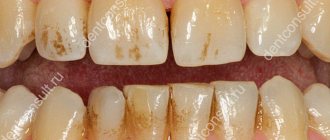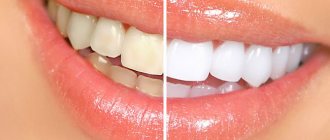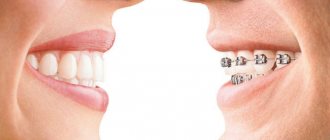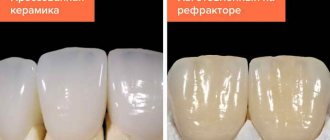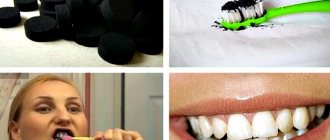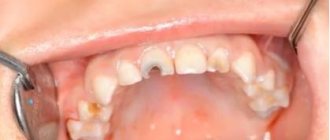Author of the article:
Soldatova Lyudmila Nikolaevna
Candidate of Medical Sciences, Professor of the Department of Clinical Dentistry of the St. Petersburg Medical and Social Institute, Chief Physician of the Alfa-Dent Dental Clinic, St. Petersburg
Whitening a pulpless tooth differs significantly from the procedure performed on healthy teeth. In the usual sense, the creation of a snow-white smile occurs with the help of a special gel, where the active substance is hydrogen peroxide in various concentrations. The composition is applied to the surface of the enamel and left for some time. In this case, additional activators can be used - laser, ultraviolet, cold light from a LED lamp, and so on. All this is necessary for oxygen to begin to be released from the gel, which discolors the yellow pigment.
Whitening a dead tooth is also done using hydrogen peroxide, but the procedure itself is radically different. Let's figure out why it is needed and how the treatment works.
Causes of pain
There are many reasons why a dead tooth may begin to cause pain. Most of them are associated either with the lack of adequate treatment and care, or with the development of the inflammatory process. The most common reasons are:
- Incomplete nerve removal. If the nerves were not completely removed, the tooth will hurt in case of the slightest inflammation.
- Poorly cleaned channel. After the nerve is removed, the dead tooth is filled, but if the canal was poorly or incompletely cleaned, microscopic particles remain under the filling material. Over time, they cause inflammation and, as a result, pain.
- Poor quality filling. When filling, the material must be inserted into the canal completely, to the very end. If part of the canal is not sealed, pathogenic microflora begins to develop there. A variant of this reason can be considered the use of low-quality filling materials. They quickly collapse, causing the channel to open.
- Inflammatory processes in the gums or periosteum. Inflammation that develops next to a dead tooth begins to spread to nearby tissues, causing pain.
Whatever the reason, if a dead tooth starts to hurt, you need to contact a dentist. Delay can lead not only to the destruction of the crown, but also to the rapid spread of inflammation.
Whitening prognosis and complications
Whitening a dead tooth is a fairly serious procedure that involves chemical action on tooth enamel. Therefore, before carrying out it, you should familiarize yourself with possible complications:
- the fragility of the result obtained, which necessitates repeated bleaching;
- The enamel of a dead tooth does not always acquire the same shade as healthy teeth. Even after lightening, the enamel can stand out from the rest;
- the enamel coating of a pulpless tooth after bleaching becomes even more fragile, in some patients it even begins to crumble and collapse;
- When applying the whitening component, the gums are irritated, so it should be done with extreme caution in patients prone to gingivitis, periodontitis and other pathologies.
Only a specialist can accurately determine whether intracanal bleaching is worthwhile or whether to look for safer alternative methods.
The Berezka dental clinic employs highly qualified specialists who can be trusted with complete confidence in tasks of any complexity and without worrying about unpleasant consequences.
Symptoms
Most often, painful sensations occur during chewing or eating hot or cold food. Some patients complain of almost constant, aching or throbbing pain.
The inflammatory process can develop rapidly. In this case, the pain is usually sharp and severe. May be accompanied by swelling of the gums and swelling of the face. Sometimes the inflammation lasts for years, and since the patient does not experience severe pain, he delays the visit to the dentist, aggravating the situation.
Crown for a living tooth
When to place a crown on a living tooth
Stages of installing a crown on a living tooth
Types of crowns. Their pros and cons
When does pulp need to be removed?
Myths about dental crowns
The question of whether it is possible to put a crown on a living tooth has gathered many myths and prejudices and divided people into two camps. When you can put a crown on a living tooth, and when not, what are the pros and cons of both methods, we will consider in this article.
First, let's figure out what a living tooth means. A tooth is an organ consisting of a protective layer (enamel, dentin, cement) and a neurovascular bundle (pulp). A tooth is considered alive if the pulp is preserved, and dead if the pulp is removed - this procedure is usually carried out in the treatment of pulpitis and periodontitis.
What to do if a dead tooth hurts
At the first appearance of pain, you should contact your dentist. Since in most cases pain is a consequence of the inflammatory process, the doctor must carry out a diagnosis.
It is imperative to assess the condition of the gums, diagnose (or exclude) diseases such as periodontal disease, periodontitis, etc. Gum disease is difficult to treat, and timely diagnosis will help to prescribe the right treatment in time.
After diagnosis, the doctor prescribes treatment aimed at eliminating the causes of pain:
- If inflammation is detected, anti-inflammatory drugs or antibiotics may be prescribed.
- The old filling is removed, the canals are cleaned, and the filling is performed again.
- The darkened crown of the dead tooth is additionally whitened to restore the aesthetics of the smile.
If you have a problem similar to that described in this article, be sure to contact our specialists. Don't diagnose yourself!
Why you should call us now:
- We will answer all your questions in 3 minutes
- Free consultation
- The average work experience of doctors is 12 years
- Convenient location of clinics
Single contact phone number: +7
Make an appointment
A specific treatment plan is prescribed individually, based on the results of the examination and the general condition of the patient’s teeth and gums. Sometimes pain in a dead tooth is a consequence of a whole range of dental problems.
Professional whitening of pulpless teeth
Whitening a dead tooth in a dental office is a completely safe and most effective procedure. One of the popular methods of professional lightening is endobleaching. The procedure is carried out in the following order:
- First, the dentist removes the old filling from the pulped tooth;
- then a special bleaching agent is introduced into its internal cavity. In most cases this is sodium perbonate, if necessary a small amount of hydrogen peroxide is added to it;
- After this, the doctor installs a temporary filling. If it is necessary to re-inject the brightening reagent, the filling is removed again. The number of procedures depends on the degree of darkening of the tooth;
- Once the desired color is achieved, a permanent filling is placed on the tooth.
In addition to intracanal bleaching, the dentist may also suggest other methods, for example, the use of veneers or crowns.
Prevention
If you have dead teeth, care must be taken to preserve them. A crown that does not receive nutrients is fragile. Over time, it can deteriorate and tooth mobility appears. Prevention of diseases in such diseases is very important.
It is imperative to ensure proper daily oral hygiene. Teeth should be brushed with a suitable toothpaste; the brush should not have very hard bristles. After eating, you need to rinse your mouth with special compounds. This will help get rid of food debris and minimize the risk of developing plaque, tartar, and the proliferation of pathogenic microorganisms.
It is important to undergo regular examinations by the dentist, and at the first appearance of pain or signs of disease, immediately go to see a doctor for diagnosis and treatment.
Features of whitening at home
Home whitening of a dead tooth is a very convenient method, but in this case it very rarely provides the required effectiveness. This is explained by the fact that at home, as a rule, products are used that only have an external effect. Sometimes such methods are not enough to lighten the enamel and without introducing special components into the tooth cavity it is simply impossible to return it to its natural shade.
At home, whitening gels are usually used, which, after penetrating the enamel, activate chemical reactions in it. It is necessary to work with such substances with extreme caution, since there is a high risk of not only damaging the enamel structure, but also damaging the mucous membranes. Therefore, it is best to trust such procedures to specialists who can prevent possible risks.
Stages of installing a crown on a living tooth
Installing a crown will require several visits to the dentist
Table 1. Stages of installing a crown on a living tooth
| Stage name | Procedures |
| Initial examination and diagnosis | Consultation with an orthopedist, examination of images, development of a treatment plan |
| Preparing to install a crown |
|
| Preparing a tooth for a crown | Using a drill, the doctor shapes the tooth so that the crown can be firmly attached to it. To do this, a layer of enamel is removed, the thickness of which depends on the thickness of the future crown. The procedure is performed under local anesthesia. |
| Making crowns | After preparation, the doctor takes impressions. Based on them, a plaster model is first made in a dental laboratory, and the crown is cast from it. If making a crown takes several days, the patient is given a temporary crown, which protects the tooth from bacteria and mechanical damage. |
| Fitting and fixation | Before installation, the doctor tries on the crown on the tooth. If the patient does not feel discomfort during fitting, the crown is fixed to the tooth using dental cement. |
Preparatory process
The procedure for whitening pulpless teeth is somewhat different from the treatment of healthy ones, in which an active concentrated substance is applied to their outer part. But dead molars and incisors change color from the inside, so that's where the whitening agent must work.
Before the procedure begins, an x-ray of the patient's teeth is taken to ensure the correctness of the canal treatment. Then the cavity of the pulpless hard tissues is re-opened and cleaned.
It is important that during the treatment process the active substance does not penetrate into the root of the dead tooth, so that tissue irritation does not occur in the area of the upper part of the tooth socket. The canal is sealed using cement or composite.
All about whitening sensitive teeth
Modern dentistry can cope with any, even the most neglected teeth, brightening them and giving them a healthy appearance. But it should be noted that whitening is a medical procedure that has its own number of contraindications.
These include:
- Individual intolerance to any components of bleaching products.
- Pregnancy and breastfeeding.
- Smoking.
- Abuse of coffee and strong tea.
- Presence of carious teeth.
- The presence of fillings of dubious quality with a broken seal.
- Active processes of inflammatory nature of the gums.
The presence of any of the above problems is a reason to postpone the whitening procedure.
In what cases is the nerve removed?
First, let's look at why pulp removal (dental nerve) or depulpation is performed. The need for depulpation arises for several reasons. Practicing dentists identify the following indications for this operation:
- the occurrence of pulpitis: damage to the neurovascular bundle due to the spread of caries,
- extensive deep carious cavity: if the defect is more than 50% of the total volume of the crown, then a filling cannot be placed (it will not hold well and will quickly fall out), and other restoration options - pins, inlays, crowns - involve depulpation,
- the presence of several carious cavities: grinding down the enamel and removing infected dentin can significantly increase the size of the defect, i.e. again, the crown will have to be restored in such a way that pulp removal will have to be carried out,
- mechanical trauma: when a horizontal root crack is detected, e.g.
- periodontitis: inflammation of the tissues of the ligamentous apparatus1 surrounding the roots.
When does pulp need to be removed?
Depulpation is not a mandatory procedure before prosthetics, but it cannot be avoided if there are the following indications.
- Advanced caries or caries at the very root of the tooth.
- Pulpitis or periodontitis.
- Partial exposure of nerves during grinding of enamel.
- Anatomically incorrect position of the tooth.
- Tooth injury, which may result in partial death of the nerves.
- Hypersensitivity.
- Low landing crown.
If there is a need to remove the nerve after the crown has been installed on a living tooth, then depulpation can be carried out without removing the crown. The doctor makes a hole, removes the nerve, and then fills the hole with polymer. After such a procedure, the prosthesis does not lose its performance properties.
Types of crowns. Advantages and disadvantages
Metal-ceramic crowns are rarely installed on a living tooth, since before installing such products, a significant layer of enamel must be removed. Therefore, metal-free structures are most often used: ceramics and zirconium dioxide.
| Ceramic crowns ➕ High aesthetics. Such crowns are indistinguishable from natural teeth. They are very light and almost imperceptible in the mouth. Ceramics can be used for people prone to allergies. ➖ high cost and fragility of the product. Ceramic crowns are not suitable for chewing teeth. |
| Zirconium dioxide crowns ➕ Considered the most in demand. Zirconium dioxide is a very strong and durable material. Just like ceramics, it looks natural, does not require significant grinding of teeth, and is hypoallergenic. ➖ high cost, not suitable for restoration of anterior teeth. |



